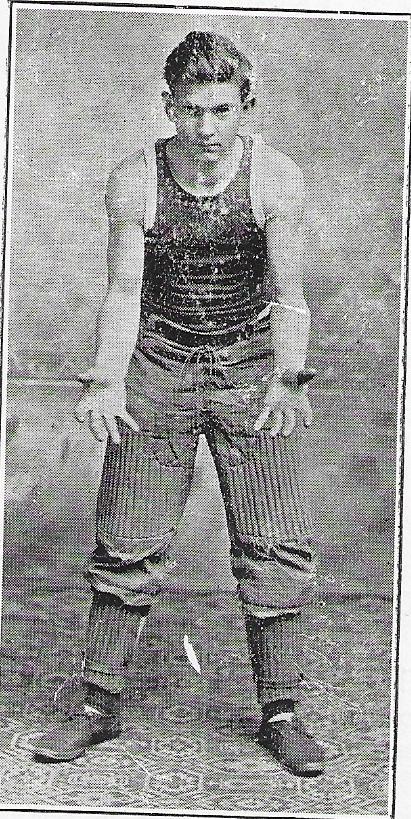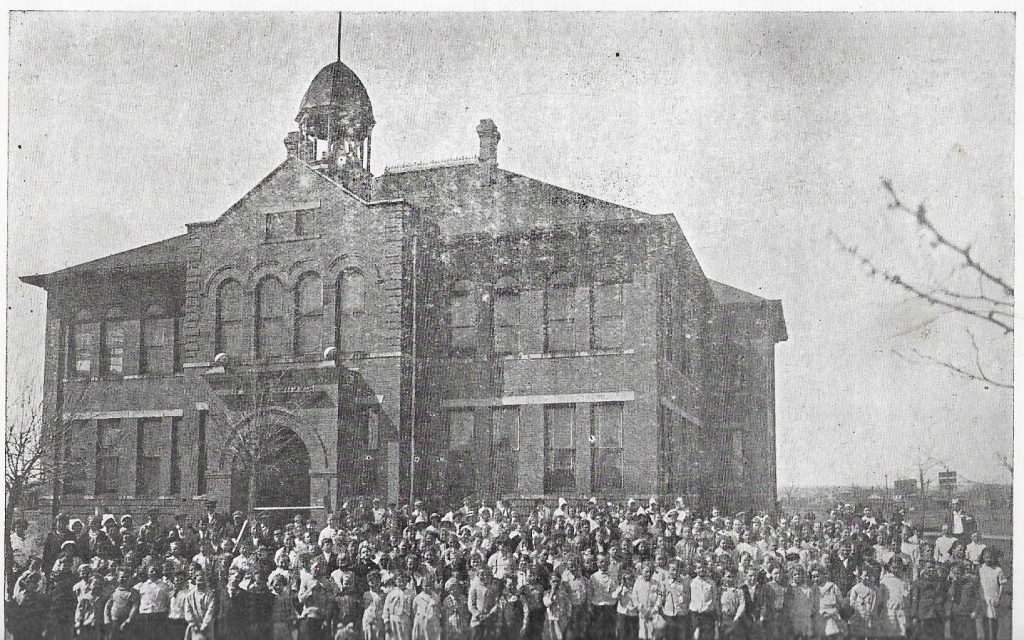by Judy Haught
From its 1901 beginning, Elk City has always provided education for its children. According to Rising from the Prairie by Lynn Kennemer, individual teachers Lizzie Caudill and Professor J. E. Delaney conducted classes for children in 1901 before the public school opened. Then on November 4, 1901, Elk City’s first public school opened with a new building. The school was met with enthusiasm and immediately began enrolling students. The November 28, 1901, issue of the Elk City Democrat contained an article stating, “The school continues to grow both in interest and numbers. It has nearly reached the two-hundred limit.”
That commitment to the education of the youth of Elk City is reflected in the 1915 school yearbook. Recently, two generous individuals donated a copy of that yearbook to Elk City Carnegie Library. Though tattered with age, “THE ELK” provides a rare look into the lives of Elk City school students and life in 1915 in general. From the faculty biographies to the photos and musings of the students to the ads in the back of the book, readers come away with a feel for the everyday existence and education in Elk City more than a hundred years ago.
The yearbook covers Elk City High-School students from freshmen through seniors and what was called “sub-freshmen” or seventh and eighth graders. Four faculty members are featured in the yearbook: A. L. Nowlin, Beulah Hurst, Emitte D. Cornelius, and Calla Rose Maddox. All faculty members held bachelor’s degrees, and some were candidates for master’s degrees. The principal was Julia Luker. She apparently was held in high regard. Her biography states that she was “thoroughly competent, not only in teaching but in managing the High School students.”
Eight students, four girls and four boys, made up the senior class. Tom Hughes was the senior class president, and May Huffman was the senior class secretary. The junior class comprised nine students, all girls; and nine girls and one boy made up the sophomore class. However, the freshman class burgeoned with thirty-one students with a fair mix of boys and girls. One wonders why the classes grew smaller as they grew older. In 1915, only a small percentage of students graduated from high school, and many young men were already in the workforce. In fact, according to Derek Thompson’s article “America in 1915: Long Hours, Crowded Houses, Death by Trolley,” in The Atlantic, the “1920 census reported that 85 percent of men over 14 were in the labor force.”
One interesting aspect of Elk City Public School in 1915 was that it had a piano department. Students learned musical theory, harmony, and sight reading. They also gave piano recitals playing pieces they had committed to memory. Students could also participate in debate. The team pictured in the annual consisted of three boys and one girl, although no details of competitions or topics were given.
The school also offered students the opportunity to participate in clubs. One of the more popular organizations was the Polyhymnian Society. The yearbook states, “All the girls of the High School were members, and the object of this organization was to help the girls to over come [sic] the greatest hindrance to girls life—timidy [sic]…they rendered a programme [sic] consisting of readings, original stories, solos and many other interesting selections.” The Alpha Club evolved from the Polyhymnian Society and included junior and senior girls. They studied short selections of authors such as Kipling and O’Henry and planned a drama.
The yearbook is full of original student writing. Poems, short stories, observations, and even a play entitled “Burlesque on Julius Caesar” are included. Some of the selections seem to contain inside jokes that today’s readers may not get. For instance, the last few lines of “Statistics of the Senior Ca” states, “We adore the Juniors (since St. Patrick’s Day.) Our favorite animal—the Donkey. Our duty is working the faculty. We are charter members of the ‘Do Nothing Club.’ Our favorite book—A pony.”
Sports were a large part of student life at Elk City High School in 1915. Boys could play football, basketball, and baseball. The only sport for girls featured in the yearbook is basketball, although the senior biographies mention that some of the girls were members of the tennis club. By far the most highly acclaimed sport in the yearbook was football. Each player was featured with his photograph, his position, his weight, and a short biography. However, a full page is dedicated to a player by the name of Tom Russell. He was a star player but was severely injured in a game at Clinton against Cordell. He had to be taken from the game and transferred to the hospital, not by an ambulance but by a car. The game continued with several more injuries though less severe.
Tom Russell

The game against Cordell was highly anticipated. The November 19, 1914, issue of the Elk City News-Democrat reported, “Elk City high school foot ball team will play the Cordell high school foot ball team at Clinton tomorrow afternoon, arrangements have been made for a special train, that lovers of the game may attend.” However, that fateful game ended the sport of football at Elk City High School due to the critical injury of Tom Russell that one fan described in the yearbook as “gruesome.”
Tom Russell’s injury was indeed life altering. The November 26, 1914, issue of the Elk City News-Democrat sums up the incident. In the game against Cordell, “Tom Russell was severely injured and is now lying in the Frances Hospital paralyzed from the waist line down unable to move or have any feeling in the lower limbs. Physicians give no hope of his recovery…” Over the years, Tom tried various medical treatments to restore his legs but without success. The newspaper reports that in June 1918, he traveled to Rochester, New York, to the Mayo Brothers Sanitarium to seek treatment. The doctors there could do nothing but said that new developments were being discovered due to the injuries sustained in World War I. Also at one point, he traveled to Enid, Oklahoma, to seek treatment from a doctor who was confident he could be cured. Despite these efforts, Tom continued to require a wheelchair.
Tom seems to have made the most of his life, and the Elk City community rallied around him. Elk City held a jubilee on November 11, 1918, to celebrate the Armistice. The newspaper reported that Tom attended the celebration in his wheelchair decked with flags and red, white, and blue ribbons. He drove a car specially equipped with hand controls, and in 1919, he was elected Justice of the Peace. Also, he ran a business developing and printing photographs.
Tom Russell died June 15, 1943, at his home in Elk City. His obituary states that he was a police judge. The obituary also repeats the story of his injury in the Elk City-Cordell football game and states that Tom “transacted his business from a wheelchair.” His grave is in Fairlawn Cemetery at Elk City.
While the tragic football game between Elk City and Cordell altered the life of a high-school senior and ended the game of football at Elk City High School, sports remained a vital part of the school’s extracurricular activities. The December 3, 1914, issue of the Elk City News-Democrat reported that “football in the E. C. H. S. is a thing of the past for Basket ball has come into its own.”
The last section of THE Elk contains ads for various businesses. Dry goods, clothing, shoes, and lumber were just a few of the products offered by Elk City merchants. Drug stores and tailor shops were also available. Elk City even had two hospitals, the Frances Hospital and the Elk City Hospital. The Elk City Hospital ad is intriguing. It states, “Has been in business about four months, have operated more than sixty cases and have not had a death. Electric Lights in every room, hot and cold water, sanitary sewerage, and all the modern equipments for the treatment of all but contagious diseases.” It is hard to imagine a hospital in this day and age advertising its electric lights and sanitary sewage.
The 1915 Elk City School yearbook offers a peek inside the lives of students from more than a century ago. In many ways, those students seem like students today. They enjoyed sports, music, and clubs and had a silly, playful side. Looking at the pictures of the high-school seniors, one cannot help but think of what lay ahead of them. How many of the young men fought in World War I? Did anyone succumb to the 1918 flu epidemic? And what about the girls? Many of them held class and club offices at a time when women were not allowed to hold offices in their own government or vote. It would be five more years before women’s suffrage became a reality. Also, in about fifteen years when those high-school students were in the midst of their adult lives, they would face the Great Depression. One can only hope that those young people faced those trying times and prevailed.
Elk City Carnegie Library has plans to digitize the 1915 Elk yearbook so that all may see it and enjoy a walk through Elk City High School history.
